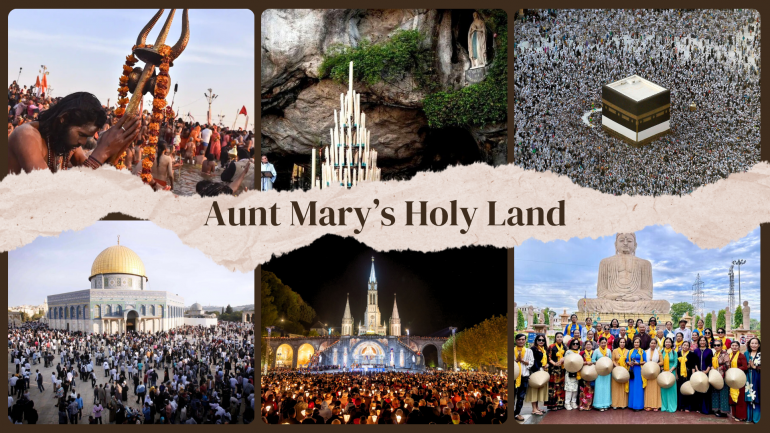Aunt Mary’s Holy Land

Aunt Mary returned from the Holy Land, her suitcase heavy with treasures. She gave each visitor a little memento. Everyone smiled, touched, grateful.
For Uncle Sam, she reserved the finest: a beautiful rosary.
He turned it over in his hands, frowning.
“Mary, aren’t these the same articles you bought here in India before your trip?”
“Yes,” she admitted cheerfully. “Things are too costly in Israel. So, I bought them here. But now they are different; they have become holy because I carried them to the Holy Land.”
Uncle Sam burst out laughing: “Ha! Yes, the beads became holy by going to the Holy Land. But what a pity, Mary, you remained the same. You too went to the Holy Land… and came back unchanged.”
In every religion, pilgrimages, retreats, and conventions are meant to transform the heart. Millions flock to Mecca, Varanasi, Lourdes, Bodh Gaya, or Jerusalem every year for pilgrimage. The recent Maha Kumbh Mela in 2025 attracted 630 million pilgrims who came to Prayagraj, India, for a holy dip in the Triveni Sangam, the confluence of the Ganges, Yamuna, and mythical Saraswati rivers, over the course of forty-five days.
Pilgrimages in Christianity lead us to the sacred places where Christ, Mary, and the saints lived, prayed, suffered, or gave their lives in witness. Standing in these holy sites awakens a profound awareness of the reality of faith. Walking the Via Dolorosa in Jerusalem, for instance, makes Christ’s Passion strikingly personal and concrete for the pilgrims. And the memory of kneeling at the Holy Sepulchre continues to strengthen and sustain them in the struggles of daily life.
The intent of pilgrimage is always noble. Every pilgrim sets out with a longing to encounter the divine, to draw closer to God, to return home refreshed in spirit. Hearts are stirred at the thought of walking where saints have walked, praying where Christ prayed, or immersing oneself in waters believed to wash away sin. The journey begins with great expectation: “This time, I will be renewed.”
The story’s humour carries a sting of truth. The question remains: Do our pilgrimages and retreats leave us like Aunt Mary’s rosary or like Aunt Mary?
The tragedy is not that people go on pilgrimage, but rather that they engage in spiritual tourism. Many return home with bags full of souvenirs, phones loaded with photographs, and stories to entertain their friends, yet their souls are as restless as before. Their tempers remain sharp, their habits unchanged, their priorities unaltered. The pilgrimage becomes an experience remembered, rather than a grace lived.
It is possible to journey to sacred rivers, kneel in famous cathedrals, or walk the very streets where prophets and saints once lived, and still return home the same. Why? Because the soul must be exposed, like bare skin to the rain. If you walk in the rain carrying an umbrella, the drops never touch you; you remain dry, unaffected. In the same way, if we go on pilgrimage shielded by routine, pride, or distraction, God’s grace cannot soak into us.
Pilgrimages are meant to be like standing in a downpour without cover, allowing the Spirit to drench, cleanse, and refresh us. Without that openness, we risk reducing holy journeys to spiritual tourism: places visited, souvenirs collected, but hearts unchanged. Therefore, late Pope Francis reminded pilgrims: “A pilgrimage is not a tourism experience. It is a journey of conversion.”
If we truly desire transformation, we must journey not only with our feet but also with our souls. A pilgrimage is not spiritual tourism, nor is it about sightseeing, taking photographs, or gathering souvenirs. Rather, it is about allowing God to touch us through the sacred atmosphere of holy places. It is an invitation to lay down the burdens of pride, anger, and resentment; to release those whom we keep imprisoned in our hearts. On pilgrimage, we are called to listen more than we speak, to immerse ourselves more than we merely observe, and to let God reshape us from within.
The greatest pilgrimage is not outward but inward, to discover God dwelling within the soul. As Uncle Sam cautioned Aunt Mary in the story, after her return from the Holy Land: “It is not enough to visit holy places. We must become holy ourselves.” The true measure of a pilgrimage is not what we carry home in our suitcases, but what we carry home in our hearts and souls.
It is easier to carry a rosary to Jerusalem than to carry Jerusalem into the heart. It is easy for beads to become “holy” because they travelled to the Holy Land. The greater challenge is for us to become holy, having met the Living God.










- Reply
Permalink